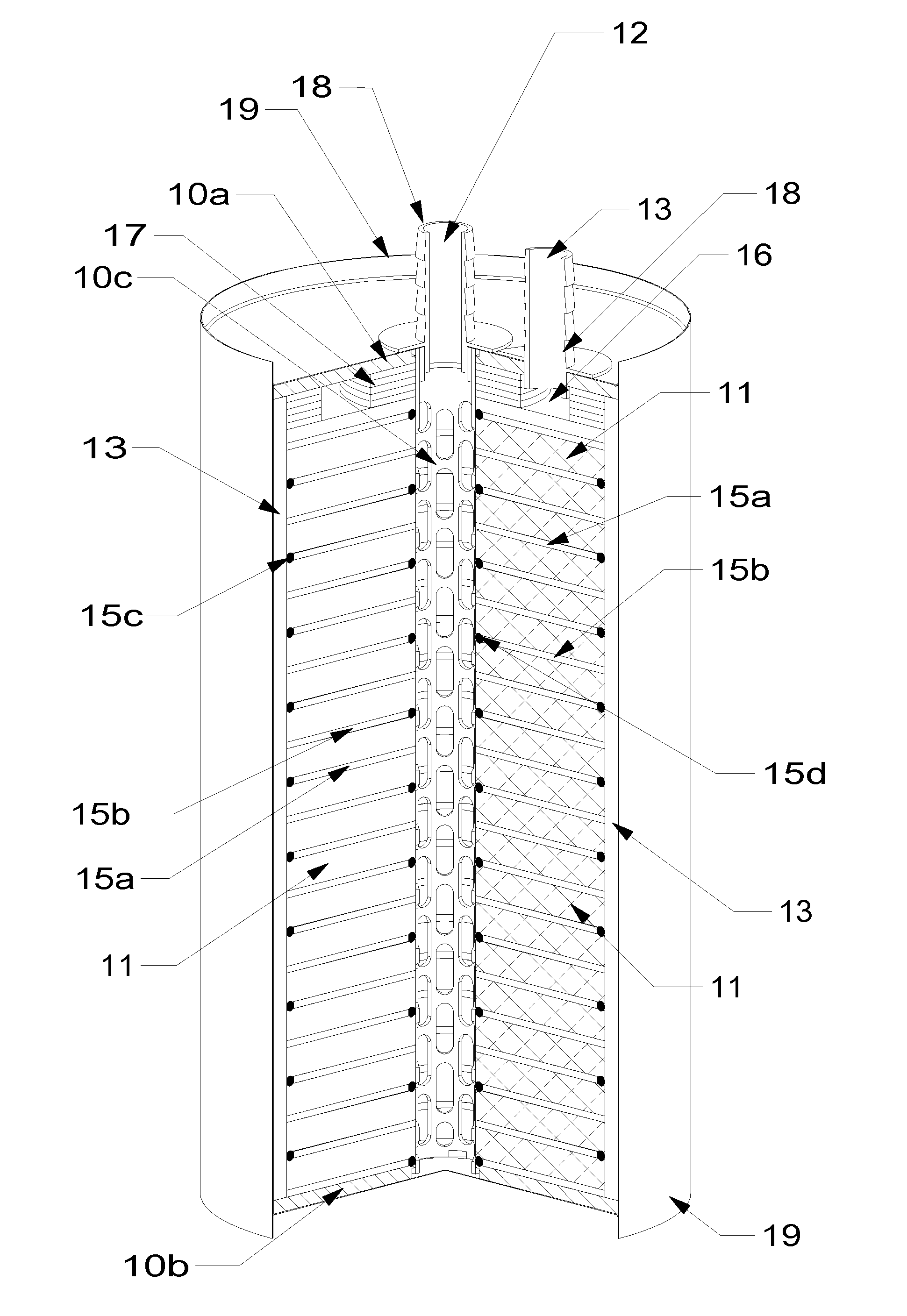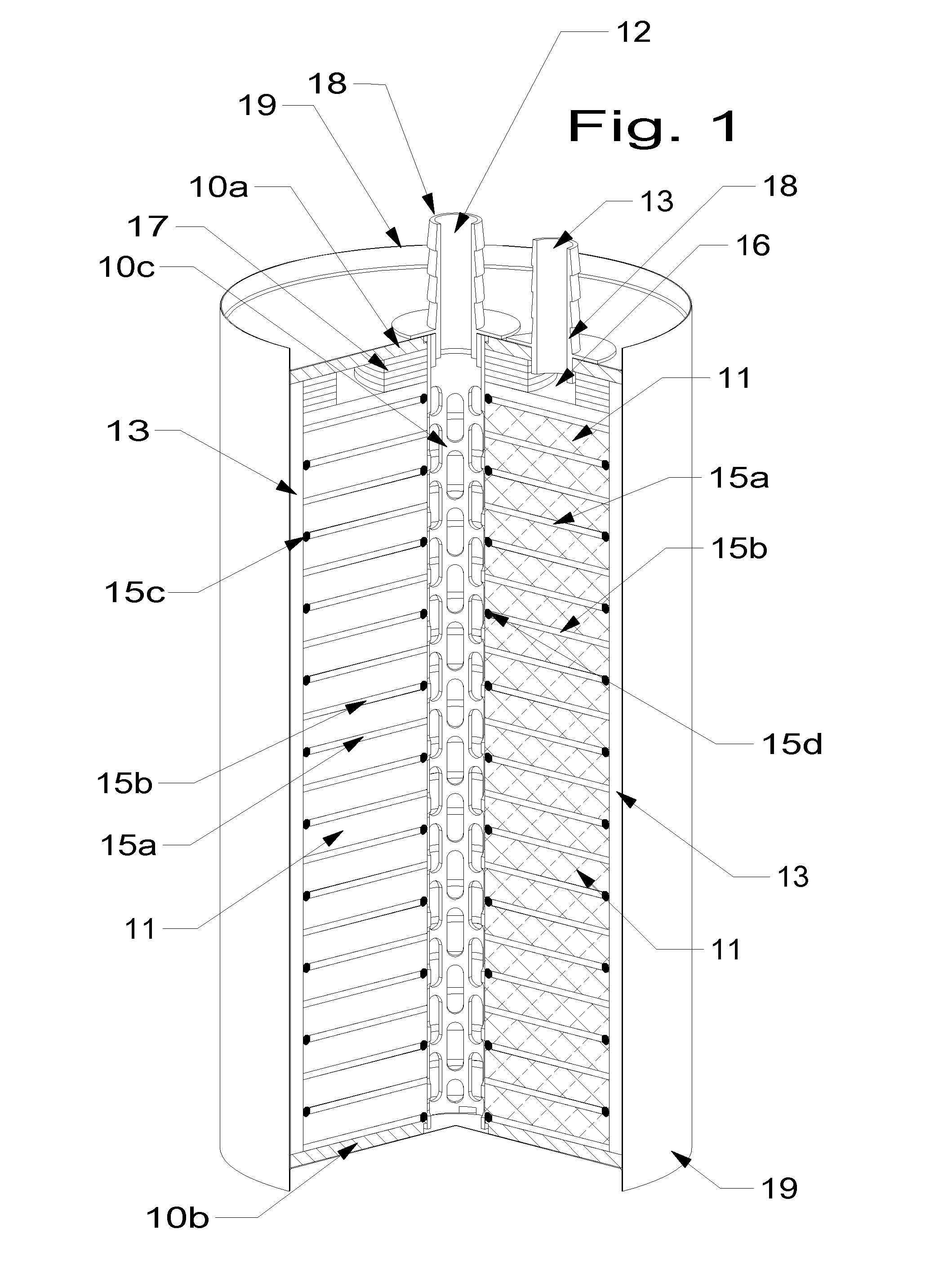Device and method for industrial cultivation of cells
a cell and cell technology, applied in the direction of biomass after-treatment, filtration separation, separation processes, etc., can solve the problems of inability to expand the volume of the reactor, the thickness of the bed is heavily limited in the celligen system, and the scalability of the bioreactor device is not good,
- Summary
- Abstract
- Description
- Claims
- Application Information
AI Technical Summary
Benefits of technology
Problems solved by technology
Method used
Image
Examples
example 1
Documented Performance
[0302]Reference is made to the work of Guozheng Wang, et. al documented in the article “Modified GelliGen packed bed bio-reactor for hybridoma cell cultures” Cytotechnology 9, page 41-49, 1992. Two test were performed on the New Brunswick Scientific product named CelliGen 2.5 litre reactor.[0303]1. a packed-bed column system packed with 50 gram FibraCel carriers (500 mL volume) in perfusion mode with 200 mL / min external pump controlled nutrient flow and ˜1×10*8 / mL cells with expression of 0.5 g / L / day MAbs.[0304]2. a packed-bed basket system packed with 110 gram FibraCel carriers (1,000 mL volume) with 3,000 mL / day nutrient flow with internal perfusion circulation pump and ˜1×10*8 / mL cells with expression of 0.5 gram / L / day MAbs.
examples 2
Polyester Fibre Discs
[0305]For the present invention, in a mass production scale, in a disc stacked body the nutrients, fresh media to the CHO micro organisms is introduced internally and pumped through the reactor constantly to the circumference drainage of the reactor. FIG. 1 illustrates how the discs are oriented with central feed inlet and circumference drainage outlet for even mass flow though each cm3 of the sheets. As the fibre based discs is able to support 1×10*8 / mL CHO cells, then:[0306]In a 70 litre container the present invention offer 4×10*4 cm3 of porous matrix volume in the stacked sheets based on non-woven fibre felt sheets[0307]Documentation from individual sources show that conservatively 1×10*8 / mL CHO cells are able to produce 500 mg / L / day proteins, when anchored on randomly oriented polyester fibre bodies (FibreCell)[0308]In 1 cm3 porous substrate of this invention the cells then under best conditions express 500 mg / mL / day protein[0309]Multiplying the volume and ...
example 3
Non-Woven Matrix
[0310]A fermenter assembly and method as depicted in FIG. 12 was tested at Aarhus University in Denmark with HEK293 cell line. The reactor as seen in FIG. 12 of which (121a) consisted of a six single envelope compartment in which non-woven polyester matrix sheets supplied by company Fibertex in Denmark. The envelope diameter was 80 millimeter and the total volume of the matrix (121) was approximately 610 cm3 and the medium volume 1908 cm3. An external media loop with a flow rate of 100 mL / min drew from the bottom of the reactor through an oxygenator (hollow fiber module UFP-3-C-4A, GE Healthcare) and a pump before medium entered the centre of the matrix module again. The oxygenator (127) on the permeate side had a steady flow of 95% air / 5% CO2 to supply oxygen and control pH. The reactor dO, pH, temperature data were collected, harvest and feeding controlled with a BioStatB DCU unit (Sartorius) and custom-made data acquisition software (Foxylogic.com).
[0311]To reduce...
PUM
| Property | Measurement | Unit |
|---|---|---|
| thickness | aaaaa | aaaaa |
| diameter | aaaaa | aaaaa |
| diameter | aaaaa | aaaaa |
Abstract
Description
Claims
Application Information
 Login to View More
Login to View More - R&D
- Intellectual Property
- Life Sciences
- Materials
- Tech Scout
- Unparalleled Data Quality
- Higher Quality Content
- 60% Fewer Hallucinations
Browse by: Latest US Patents, China's latest patents, Technical Efficacy Thesaurus, Application Domain, Technology Topic, Popular Technical Reports.
© 2025 PatSnap. All rights reserved.Legal|Privacy policy|Modern Slavery Act Transparency Statement|Sitemap|About US| Contact US: help@patsnap.com



